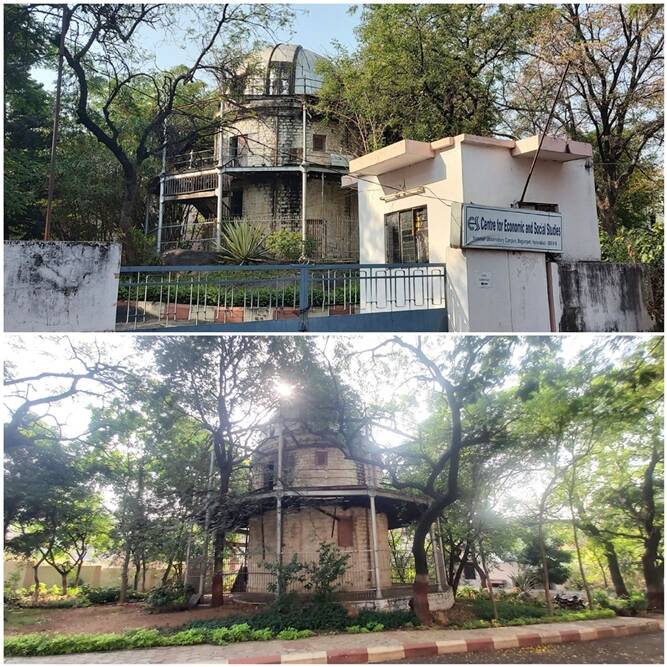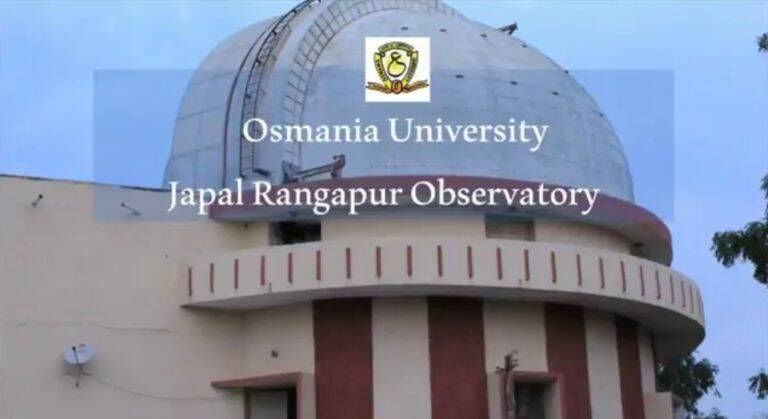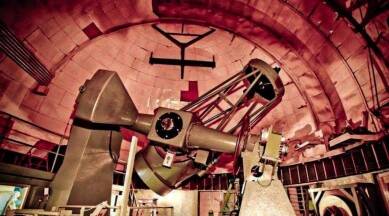Save heritage slogan is always on with historic monuments, in this category the two structures and their many vintage instruments are facing sheer neglect and lack of maintenance of Nizamiah Observatory and Japal-Rangapur Observatory in Hyderabad.

Osmania University (OU), the custodian of the two structures and their many vintage instruments, is distressed about the lack of funds or faculty strength to adopt the latest technologies.
The Nizamiah Observatory in Hyderabad, which could have well been a relevant reminder of the city’s scientific heritage and its historic contributions to the field of astronomy in India, is a forgotten monument and a symbol of neglect today. Its two cylindrical stone structures with domes built over a century ago are a grim reflection of its glorious past.
Meanwhile, with its main 48-inch telescope lying dysfunctional for over two decades, the Japal-Rangapur Observatory that replaced the former in the 1980s is heading in the same direction. Osmania University (OU), the custodian of the two structures and their many vintage instruments, is distressed about the lack of funds or faculty strength to adopt the latest technologies. Given the situation, PhD scholars of the astronomy department, the lone one in the two Telugu-speaking states, are forced to utilise astronomical observatories elsewhere for their advanced research and analysis.
Established in 1901 as a passion project of an England-educated nobleman, Nawab Zafar Yar Jung Bahadur, at his estate in Phisalbanda with the support of the sixth Nizam of Hyderabad Mir Mahbub Ali Khan Bahadur, the Nizamiah Observatory was taken over by the Nizam’s government in 1908, a year after the Nawab’s death. It was relocated to Begumpet and brought under the Osmania University later in 1919. Incidentally, the facility was one among the only two observatories in the country at the time of Independence.
In the book, ‘Astronomy in India – A Perspective’, published by the Indian National Science Academy, authors Rajesh Kochchar and Jayant Narlikar note that the formal establishment of the Nizamiah Observatory had to await the founder’s death. In 1908, they say, this Observatory replaced Santiago Observatory in Chile to take part in an ambitious international programme called Carte-du-Ciel, which aimed to photographically map the whole sky by assigning various celestial zones to 18 different observatories around the world. The Nawab’s eight-inch Cooke Astrograph and a 15-inch Grubb refractor telescope were used in the Carte-du-Ciel programme.
In 1914, the Nizam brought in Robert John Pocock, ‘a protege of influential Oxford professor Herbert Hall Turner, direct from Oxford, armed with a special grant’ as the new director to replace Arthur Brunel Chatwood who had been brought from England in 1908 for an annual salary of 1200 British pounds. According to the authors, when the programme ended in 1946, a total of 7,63,542 stars had been observed and 12 volumes of work published. The Observatory, as a community service, also kept standard time and prepared government calendars in Urdu and English.
Post-Independence, it was the University Grants Commission that initiated the modernisation of the Nizamiah Observatory in 1954. Most of the funds came from the US Government through the India Wheat Loan Educational Exchange Programme. According to the two authors, after the OU set up its Department of Astronomy in 1959, it received a special grant from 1964 to 1979. A 48-inch (1.2 m) reflector telescope of Messers JW Fecker of Pittsburgh was brought in 1964 and the same was finally commissioned at a new site in Japal-Rangapur village in 1968.
While the new Observatory, about 50-km from the city, gained prominence, the locales of Begumpet made way for urbanisation and concretisation. Citing light pollution, the Nizamiah Observatory was vacated and its vintage instruments were shifted to the OU campus in 1983. Over time, the main telescope at Japal-Rangapur Observatory, too, has become obsolete and has been out of use for about two decades for the same reasons. The university, officials say, has no funds to procure the latest astronomical instruments for its students to use.

While the 48-inch telescope has been non-functional, students of the Department of Astronomy at the OU use a basic 12-inch telescope at the Observatory for their practicals. Research scholars, however, are currently using the same to record preliminary observations with the help of a basic charge-coupled device to produce images. “With the preliminary observations and analysis, they prepare proposals and apply for telescopic time on a bigger telescope available at Kavalur Observatory (Vainu Bappu Observatory operated by the Indian Institute of Astrophysics at Kavalur in Tamil Nadu),” said a faculty member.
“With available facilities, we have been focussed on keeping alive the curiosity in astronomy among youngsters. Yes, currently students are going out and collecting data. We have been trying for funds from the government and other sources for acquiring the latest technologies. It will help research if modern equipment is provided,” says Dr D Shanti Priya, head of the astronomy department. The department had in the past proposed the purchase of a 0.2-meter robotic telescope that can be operated remotely. It would cost between Rs 3 to 5 crore for one such telescope, she adds.
Noting that the university is looking into the request from the department for new telescopes, Dr B Veeraiah, who is the principal of the University College of Science, says that the huge costs involved and the lack of sufficient faculty strength have come as a major obstacle in their procurement. “The cost involved is in crores.
The corporates may not fund such big amounts and funding through foreign collaborations requires a minimum faculty strength in the department. We are lagging in that aspect. But the vice-chancellor is striving for funds and has assured recruitment shortly,” said Dr Veeraiah, who is also the acting director of the Observatory.
The Department of Astronomy at the OU has about 60 post-graduate students in its MSc programme and another 12 research scholars at present. Against a sanctioned teaching staff strength of 24 members, the department at present has four regular faculty members and another hired on contract. The last major recruitment in the department was held in 2013, before the formation of the new state of Telangana.
Vouching for the protection of the city’s heritage, P Anuradha Reddy, the co-convenor of the Indian National Trust for Art and Cultural Heritage (INTACH)-Telangana, credits the vision of the Nizams for making Hyderabad a world-class city back in the day.
According to her, the Nizam was extremely supportive not only of the Observatory but a whole lot of initiatives that helped Hyderabad stand apart. “So, what if these telescopes are defunct? It will be a good idea to bring it all back to the city.
There is so much history that needs to be recorded. These two stone structures in the heart of the city can be a museum where you display the instruments, the documentary and photographic evidence of the works, and so on,” she adds.
Dr BG Siddharth, a renowned astrophysicist, agrees with Reddy when he says the Observatory that forms the city’s century-old astronomical heritage needs preservation. According to him, the Nizamiah Observatory comes from an era when the British were interested in making their observations and did not encourage Indian talent. “It (Nizamiah Observatory) was a very important place for making observations. For an observatory, one requires proper manpower to run it.

Over the years, it is a pity that it has become a showpiece or museum piece. Japal-Rangapur observatory seems to be going the same way for lack of personnel to look after it,” says Dr Siddharth who till his retirement worked as the founder-director of BM Birla Science Centre in Hyderabad.
The Nizam-era building at Begumpet could be used to house an astronomical museum, agrees Dr Veeraiah. “The equipment that was transferred from Nizamiah Observatory to Japal-Rangapur Observatory can be brought back to the city.
The building can be used as a museum. It needs to be discussed with all faculty members,” he agrees. In the same breath, Dr Siddharth adds that to prevent Japal-Rangapur Observatory from becoming a relic of the past just like the Nizamiah Observatory, huge investments in modern equipment and qualified human resources are necessary. Dr Veeraiah believes that efforts in that direction once fructified will benefit students from the region. #KhabarLive #hydnews
